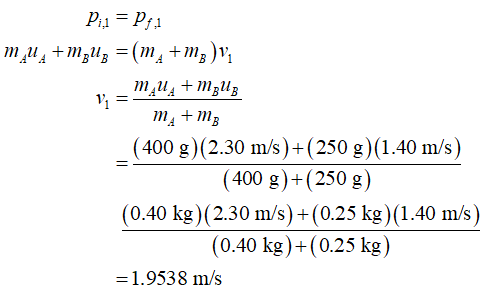Three objects undergo successive inelastic collisions. Object A, of mass 400 grams travels east at a velocity of 2.30 m/s towards object B of mass 250 grams which is also travelling east but with a velocity of 1.40 m/s. A and B collide and then undergo a second collision with object C, mass 300 grams travelling at velocity u. Calculate what the velocity of object C is, assuming that after the second collision event all objects come together as one with a common velocity of 0.100 m/s westwards. (Note for your answer, velocities east are positive, velocities west are negative.)
Three objects undergo successive inelastic collisions. Object A, of mass 400 grams travels east at a velocity of 2.30 m/s towards object B of mass 250 grams which is also travelling east but with a velocity of 1.40 m/s. A and B collide and then undergo a second collision with object C, mass 300 grams travelling at velocity u. Calculate what the velocity of object C is, assuming that after the second collision event all objects come together as one with a common velocity of 0.100 m/s westwards. (Note for your answer, velocities east are positive, velocities west are negative.)
College Physics
11th Edition
ISBN:9781305952300
Author:Raymond A. Serway, Chris Vuille
Publisher:Raymond A. Serway, Chris Vuille
Chapter1: Units, Trigonometry. And Vectors
Section: Chapter Questions
Problem 1CQ: Estimate the order of magnitude of the length, in meters, of each of the following; (a) a mouse, (b)...
Related questions
Question

Transcribed Image Text:Three objects undergo successive inelastic collisions. Object
A, of mass 400 grams travels east at a velocity of 2.30 m/s
towards object B of mass 250 grams which is also travelling
east but with a velocity of 1.40 m/s. A and B collide and then
undergo a second collision with object C, mass 300 grams
travelling at velocity u. Calculate what the velocity of object C
is, assuming that after the second collision event all objects
come together as one with a common velocity of 0.100 m/s
westwards. (Note for your answer, velocities east are positive,
velocities west are negative.)
Expert Solution
Step 1
Consider a system of the objects A and B, apply conservation of momentum on the system, and solve for the velocity (v1) of the system after the first collision.

Step by step
Solved in 2 steps with 2 images

Knowledge Booster
Learn more about
Need a deep-dive on the concept behind this application? Look no further. Learn more about this topic, physics and related others by exploring similar questions and additional content below.Recommended textbooks for you

College Physics
Physics
ISBN:
9781305952300
Author:
Raymond A. Serway, Chris Vuille
Publisher:
Cengage Learning

University Physics (14th Edition)
Physics
ISBN:
9780133969290
Author:
Hugh D. Young, Roger A. Freedman
Publisher:
PEARSON

Introduction To Quantum Mechanics
Physics
ISBN:
9781107189638
Author:
Griffiths, David J., Schroeter, Darrell F.
Publisher:
Cambridge University Press

College Physics
Physics
ISBN:
9781305952300
Author:
Raymond A. Serway, Chris Vuille
Publisher:
Cengage Learning

University Physics (14th Edition)
Physics
ISBN:
9780133969290
Author:
Hugh D. Young, Roger A. Freedman
Publisher:
PEARSON

Introduction To Quantum Mechanics
Physics
ISBN:
9781107189638
Author:
Griffiths, David J., Schroeter, Darrell F.
Publisher:
Cambridge University Press

Physics for Scientists and Engineers
Physics
ISBN:
9781337553278
Author:
Raymond A. Serway, John W. Jewett
Publisher:
Cengage Learning

Lecture- Tutorials for Introductory Astronomy
Physics
ISBN:
9780321820464
Author:
Edward E. Prather, Tim P. Slater, Jeff P. Adams, Gina Brissenden
Publisher:
Addison-Wesley

College Physics: A Strategic Approach (4th Editio…
Physics
ISBN:
9780134609034
Author:
Randall D. Knight (Professor Emeritus), Brian Jones, Stuart Field
Publisher:
PEARSON